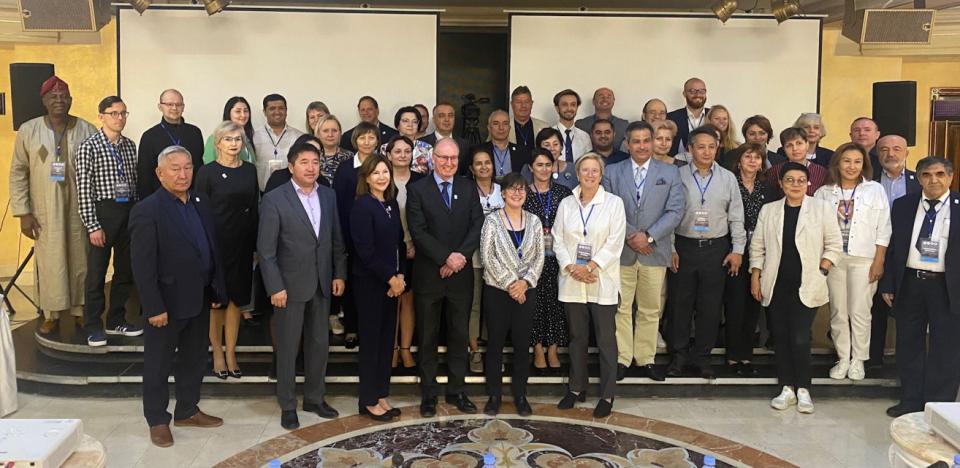Cancer treatment hindered by equipment shortages in ex-Soviet countries
Access to diagnostic imaging and radiotherapy technologies for patients with cancer in the Baltic countries, eastern Europe, central Asia, and the Caucasus: a comprehensive analysis, Dosanjh et. al., The Lancet Oncology
Professor Manjit Dosanjh is a member of the Lancet Oncology Commission on Radiotherapy and Theranostics; here she comments on how physics has a key role to play in tackling the disparity in access to essential radiotherapy treatment and how advances will transform treatment in the future.
"You managed to unite us all in one paper. This is an unbelievably tremendous job” - Gulam Babayev, PhD, Azerbaijan Regional Office of Science and Technology Center in Ukraine (STCU), Baku, Azerbaijan
A major new study has identified crucial gaps in access to diagnostic imaging and radiotherapy technologies for cancer patients in former Soviet Union countries encompassing the Baltics, Eastern Europe, Central Asia, and the Caucasus.* Addressing these gaps could ultimately improve the ability of healthcare services to rapidly diagnose and effectively treat cancer patients, resulting in higher survival rates. The findings have been published today in The Lancet Oncology.
The former Soviet Union region is ranked second highest in the world (only behind Sub-Saharan Africa) in the proportion of radiotherapy cancer treatments delivered mainly with ‘outdated’ cobalt-60 machines. To date, there has been a critical lack of understanding about the obstacles inhibiting the transition to more effective linear accelerators (LINACs) for external beam radiation therapy (EBRT).
LINACs are more precise and effective than cobalt-60 machines, and safer since they do not use radioactive materials. However, LlNACs depend upon skilled staff and regular maintenance, meaning that healthcare providers are required to make a significant investment in infrastructure and training.
This new Access to Radiotherapy Technologies (ART) study provides a window to understand the challenges that these inadequately resourced countries currently face and how adequate funding could improve their RT and other cancer-related services.
The analysis was based on available national cancer data and a combination of surveys and workshops conducted with cancer specialists (including radiation oncologists, medical physicists and researchers) and regulators. Areas evaluated included staff capacity, availability of imaging and radiation therapy technologies, radiation safety and security and training opportunities.
Although the characteristics of the surveyed countries vary significantly in terms of total population, GDP/capita, cancer incidence and cancer death to cancer incidence ratios, the study identified a number of key trends.
In general, more economically developed countries, such as Estonia, Latvia, and Lithuania have greater diagnostic imaging and radiotherapy equipment capacity, as well as greater radiation oncology and human resources. The same surveyed countries have better cancer survival rates.
The Baltic countries have both above average EBRT capacity and number of oncologists. Georgia has above average external beam radiotherapy equipment capacity while Kazakhstan and Ukraine have above average numbers of oncologists. Whereas countries in Eastern Europe and Central Asia have lower RT equipment capacity and lower RT staffing levels.
However, greater equipment capacity does not always translate into improved survival. For instance, Georgia has above regional average RT equipment capacity but also has the highest cancer mortality rate. According to the researchers, this underscores the importance of having sufficient numbers of trained staff.
The countries with the lowest GDPs and lowest EBRT capacities (such as Kazakhstan, Azerbaijan, Uzbekistan, Kyrgyzstan and Tajikistan) have the lowest reported cancer death rates. According to the researchers, this is likely because the lack of diagnostic imaging equipment in these countries is causing many cancer patients to go undiagnosed. In support of this, the countries with the highest GDPs and highest EBRT capacity have the highest reported death rates but the most favourable cancer death to cancer incidence ratios (MIRs).
The results highlight the critical need to provide many more educational and training opportunities. Almost all countries studied require more medical physicists, radiation therapy technologists, and engineers to maintain radiation therapy equipment.
*The countries examined were Estonia, Latvia, Lithuania, Moldova, Ukraine, Armenia, Azerbaijan, Georgia, Kazakhstan, Kyrgyzstan, Tajikistan, and Uzbekistan.
Lead researcher Professor Manjit Dosanjh (Department of Physics, University of Oxford) said: “Improving cancer survival in ART countries requires a multilayered approach that includes building human and technical capacity, improving cancer detection rates, and improving the accessibility to and quality of all cancer care. Because of major differences in available resources, each country needs to develop a specific roadmap to improve its cancer program.”
The International Cancer Expert Corps (ICEC)’s Chief Scientific Program Director, Dr David Pistenmaa, stated, “Having treated cancer patients with linear accelerators but also with cobalt-60 machines, I can appreciate the significant technical advantages of a LINAC that will be available for these radiation oncologists to treat their patients. The challenges they face are daunting but can be overcome with adequate financial, education, and training resources as evidenced by the progress made by the Baltic countries.”
The study was carried out by the ICEC, an NGO based in the USA. It was led by global cancer experts from Oxford University, Swansea University and Medical School, UK; International Atomic Energy Agency (IAEA), Austria; King Hussein Cancer Center, Jordan; Cyril and Methodius University, Skopje, North Macedonia; University of Abuja, Nigeria; and SEEIIST (South East European International Institute for Sustainable Technologies) together with representatives from the ART study countries: Estonia, Latvia, Lithuania, Moldova, Ukraine, Armenia, Azerbaijan, Georgia, Kazakhstan, Kyrgyzstan, Tajikistan, and Uzbekistan.

